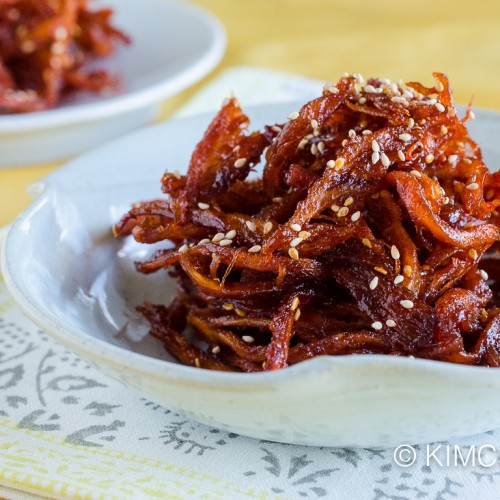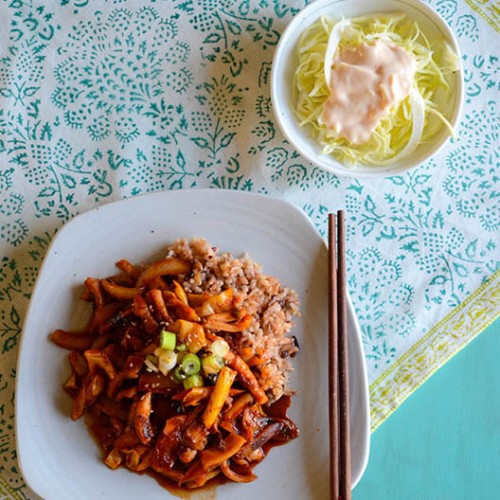What is Ojingeo (Squid) ?
Ojingeo 오징어 (Squid) is any of more than 300 species of mollusks that have 10 arms/legs and a tubular body. Koreans mostly eat 3 different groups of squids and they are many confusing terms used to describe them but when viewed from the scientific name group point of view, the 3 groups belong basically to two 'family' scientific classifications. Ommastrephidae and Loliginidae family.
Ommastrophidae family is 살오징어과 (Sal Ojingeo Kwa) in Korean whereas the Loliginidae family is called 꼴뚜기과 (Kkolttugi Kwa). But the term Ojingeo and Kkolttugi 꼴뚜기 are used interchangeably so it can be confusing. Mostly Kkolttugi refers to the thinner, often smaller mollusk with 10 short legs but also sometimes the small babies of the large squids.
Hanchi 한치 is another name Koreans use to usually refer to these smaller ones that belong to the Loliginidae family, especially with thinner skin and short (3 cm) legs.
So, in Korea, there are Ojingeo, Kkolttugi and Hanchi.
Similarly, you may be confused about Calamari vs Squid and how that relates to squids used in Korean cooking.
What's the difference between Calamari and Squid?
There is incorrect info online that says Calamari is a cooked version of squid or even that Calamari and Squids are basically the same thing but since it sounds more appetizing than squid, people call it Calamari..?.. no.. that's not correct.
To clear up the confusion about calamari, my good friend Judith H. asked (on my behalf) Squid expert Roger Hanlon, who also asked expert Jose Irissari. Here is his reply:
The name CALAMARO is an Italian language name. In Italy, they use that name for Loligo Vulgaris
* Calamaro is used for famiglie Loliginidae , as Loligo vulgaris
* Totano is used for famiglie Ommastrephidae as Totano (Todarodes sagittatus)
The words CALAMARI and TOTANI are the "plural" terms of CALAMARO and TOTANO in Italian language.So normally they call it Calamari in food recipes ( because they cook many specimens together)
Our special thanks to these learned gentlemen for this clarification and my sincere thanks to my friend Judith for helping me with this post.
And now, having researched and learned about the different species, I think we can safely say that Calamari belongs to the same family as Korean Kkoltugi (Loliginidae) whereas Squid (Totano) belongs to Korean Sal-ojingeo (Ommastrephidae) family.
In terms of individual squid or calamari species used in Korean cooking, we can say that it's usually going to be one of the 3 below -
- Sal Ojingeo 살오징어 (Japanese Common Squid- Todarodes Pacificus) belongs to the Ommastrophid. They also go by Japanese Flying Squid or Pacific Flying Squid. Usually about 30 cm long.
- Hwasal Ojingeo 화살오징어 (Far Eastern Arrow Squid or Spear squid - Heterololigo Bleekeri formerly Loligo Bleekeri) aka Hwasal Kkolttugi 화살꼴뚜기 are mollusks that belong to Loliginidae family (aka Kkolttugi Kwa 꼴뚜기과 in Korean). This species is also called Hanchi in Korean and have a thinner skin and is more tender which makes it ideal to be eaten raw as Hanchi Hoe 한치회 or sashimi.
- Cham Kkolttugi 참꼴뚜기 (Beka squid - Loliolus Beka) belongs to the Loliginidae family and Loliolus Genus. These are usually about 7 cm in length.
Where and What To Buy
Many grocery stores with a seafood section will carry squid, although it is easily available at Korean and Asian grocery stores frozen as well.
How to Use/Cook
- raw as Hoe회 - the thinner and smaller Hanchi is sliced thin and served with cho gochujang
- stir fry - sautee with spicy gochujang sauce with vegetables to make Ojingeo Bokkeum. Also stir fry with pork belly in spicy gochujang sauce for Osam Bulgogi
- banchan - use shredded dried squid to make Ojingeochae Bokkeum
- snack - just enjoy dried squid as is or grill it then enjoy as snack with beer
- twigim - deep fry squid with batter
- you can also blanch and enjoy it plain with some cho gochujang sauce
How to Clean/Store
Store squid frozen. They store and cook well from frozen state. Not an absolute must but the skin is usually removed for a cleaner presentation.
If squid comes whole without the gut removed then you need to cut open the tubular body and remove the innards. You also need to cut off the top part of the head where the eyes and mouth are located.
You can see how I clean the squid from this Ojingeo Bokkeum recipe post.
Nutrition/Health Info
Good source of vitamin C, Iron and Calcium. High in protein and Omega 3 fatty acids.








